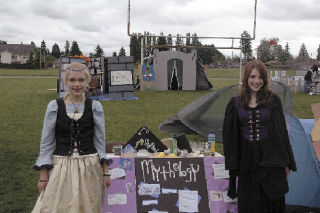MARYSVILLE — It was largely about guillotines and torture devices, bad food with bugs in it, weapons that could cut a man in two and blood letting for medicinal purposes, not to mention rats and the Black Death.
And needless to say, the seventh-grade students of Marysville Middle School seemed to be enjoying every minute of it.
“The kids really get into it. It’s about cool history, cool weapons,” said seventh-grade English and social studies teacher Susanne Pearson, who was in charge of putting together the middle school’s second annual Medieval Fair held May 22 on the school’s athletic field.
Working in teams, the middle school’s seventh-graders had six weeks to research and put together displays on medieval topics of their own choosing.
Student Natahalie Shields, 13, with help from dad John, put together one of the most towering displays: a six-foot-plus high nearly fully functioning guillotine.
Acting as executioner, Bruce Erickson, 13, said the French invented the guillotine as a means of dispatching nobles who had fallen out of favor. But use of the instrument spread and Bruce said many towns had a guillotine prominently displayed as a reminder to would-be evildoers of the possible consequences of their actions.
For her part, Natahalie said the guillotine actually was one of the milder instruments used to deal with alleged criminals. She had a display picturing 23 torture devices. As her favorite, Natahalie mentioned the iron maiden, which was essentially a large coffin with spikes that impaled the unlucky person inside when closed.
Probably predictably, weapons and armor were popular topics among the students. Dylan Speongenberg, 13, said the picture many people have of the knight in shining armor did not originate in the Middle Ages. Instead, knights and fighters mostly used chain mail, which covered every inch of your body except your feet.
Although she demonstrated her sword fighting skills with a wooden weapon, Patricia Berryman, 13, said real medieval swords were designed to be strong enough to cut a man in half, whether or not he was wearing chain mail.
For heavier warfare, various students said catapults were common. But Cole Miller and Frank Willett, both 13, were part of the team that built a scaled-down but fully working trebuchet. Using counter weights, trebuchets could fling rocks or other debris, sometimes including dead bodies, at the enemy. The model built by the student team flung a tennis ball about 30 yards.
Not incidentally, warfare and swift justice with a guillotine were not the only sources of death during the Middle Ages. Carried by flea-infested rats, Kelly Barrett, 13, said the plague or Black Death killed some 25 million people throughout Europe. You probably remember the nursery rhyme “Ring around the rosy,” but its subject matter is hardly kid’s stuff.
Kelly said the “ring around the rosy” was a red mark that appeared around the sores created by the plague. “A pocket full of poesy’s” referred to the flowers people carried to ward of the stench of all those dead bodies. And “the ashes, ashes, we all fall down,” line clearly referred to the death of plague victims.
For the peasantry, which included the vast majority of the Medieval population, the main source of food was barley, which they ate nearly everyday, according to Analia Alaniz, 12. She said the commoners often added ale to their recipes just to add flavor to their daily food.
Music was common during the Middle Ages, said Robert Mook, 13. The most widespread instruments were lutes, a forerunner of what is now known as the mandolin. Robert said not much is known about the songs people sang and played back then as few have survived into modern times.
Of course, the nobles of medieval times lived in castles. Sitting with a Lego version he helped build, Edwin Lusher, 13 rattled off numerous facts about the structures, perhaps the most notable being that they were not as big as many think.
“Learning this stuff, this is what happens when you read,” Edwin said. He added he would have been willing to live in medieval times. Why?
“They didn’t have to take showers,” he quipped.



